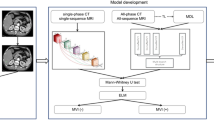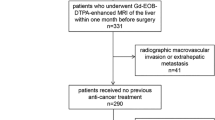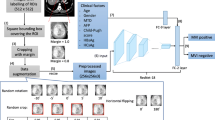Abstract
Purpose
This study aimed to build and evaluate a deep learning (DL) model to predict vessels encapsulating tumor clusters (VETC) and prognosis preoperatively in patients with hepatocellular carcinoma (HCC).
Methods
320 pathologically confirmed HCC patients (58 women and 262 men) from two hospitals were included in this retrospective study. Institution 1 (n = 219) and Institution 2 (n = 101) served as the training and external test cohorts, respectively. Tumors were evaluated three-dimensionally and regions of interest were segmented manually in the arterial, portal venous, and delayed phases (AP, PP, and DP). Three ResNet-34 DL models were developed, consisting of three models based on a single sequence. The fusion model was developed by inputting the prediction probability of the output from the three single-sequence models into logistic regression. The area under the receiver operating characteristic curve (AUC) was used to compare performance, and the Delong test was used to compare AUCs. Early recurrence (ER) was defined as recurrence within two years of surgery and early recurrence-free survival (ERFS) rate was evaluated by Kaplan–Meier survival analysis.
Results
Among the 320 HCC patients, 227 were VETC− and 93 were VETC+ . In the external test cohort, the fusion model showed an AUC of 0.772, a sensitivity of 0.80, and a specificity of 0.61. The fusion model-based prediction of VETC high-risk and low-risk categories exhibits a significant difference in ERFS rates, akin to the outcomes observed in VETC + and VETC− confirmed through pathological analyses (p < 0.05).
Conclusions
A DL framework based on ResNet-34 has demonstrated potential in facilitating non-invasive prediction of VETC as well as patient prognosis.
Graphical abstract






Similar content being viewed by others
Abbreviations
- HCC:
-
Hepatocellular carcinoma
- VETC:
-
Vessels encapsulating tumor cluster
- DCE-MRI:
-
Dynamic contrast-enhanced MRI
- DL:
-
Deep learning
- AUC:
-
Area under the receiver operating characteristic curve
- AFP:
-
Alpha-fetoprotein
- AP:
-
Arterial phase
- DP:
-
Delayed phase
- PP:
-
Portal-venous phase
- ALB:
-
Serum albumin
- ALT:
-
Alanine aminotransferase
- AST:
-
Aspartate aminotransferase
- GGT:
-
Gamma-glutamyl transferase
- HBV:
-
Hepatitis B virus
- PT:
-
Prothrombin time
- BCLC:
-
Barcelona clinic liver cancer
- CI:
-
Confidence interval
- IQR:
-
Interquartile range
- ROC:
-
Receiver operating characteristic
- ROI:
-
Region of interest
- DSC:
-
Dice similarity coefficient
- Gd-EOB-DTPA:
-
Gadolinium-ethoxybenzyl-diethylenetriamine pentaacetic acid
- HBP:
-
Hepatobiliary phase
- ER:
-
Early recurrence
References
Sung H, Ferlay J, Siegel RL, et al. Global Cancer Statistics 2020: GLOBOCAN Estimates of Incidence and Mortality Worldwide for 36 Cancers in 185 Countries. CA Cancer J Clin. 2021. 71(3): 209-249.
Forner A, Reig M, Bruix J. Hepatocellular carcinoma. Lancet. 2018. 391(10127): 1301-1314.
Hasegawa K, Kokudo N, Makuuchi M, et al. Comparison of resection and ablation for hepatocellular carcinoma: a cohort study based on a Japanese nationwide survey. J Hepatol. 2013. 58(4): 724-9.
Llovet JM, Kelley RK, Villanueva A, et al. Hepatocellular carcinoma. Nat Rev Dis Primers 2021; 7:6.
Ding T, Xu J, Zhang Y, et al. Endothelium-coated tumor clusters are associated with poor prognosis and micrometastasis of hepatocellular carcinoma after resection. Cancer 2011; 117:4878-4889.
Fang JH, Zhou HC, Zhang C, et al. A novel vascular pattern promotes metastasis of hepatocellular carcinoma in an epithelial-mesenchymal transition-independent manner. Hepatology. 2015. 62(2): 452-65.
Renne SL, Woo HY, Allegra S, et al. Vessels Encapsulating Tumor Clusters (VETC) Is a Powerful Predictor of Aggressive Hepatocellular Carcinoma. Hepatology. 2020. 71(1): 183-195.
Fang JH, Xu L, Shang LR, et al. Vessels That Encapsulate Tumor Clusters (VETC) Pattern Is a Predictor of Sorafenib Benefit in Patients with Hepatocellular Carcinoma. Hepatology. 2019. 70(3): 824-839.
F.M. Chen, M. Du, X. Qi, et al., Nomogram Estimating Vessels Encapsulating Tumor Clusters in Hepatocellular Carcinoma From Preoperative Gadoxetate Disodium-Enhanced MRI, J Magn Reson Imaging (2022) .
Zhu Y, Yang L, Wang M, et al. Preoperative MRI features to predict vessels that encapsulate tumor clusters and microvascular invasion in hepatocellular carcinoma. Eur J Radiol 2023; 167:111089.
Fan Y, Yu Y, Hu M, et al. Imaging features based on Gd-EOB-DTPA-enhanced MRI for predicting vessels encapsulating tumor clusters (VETC) in patients with hepatocellular carcinoma. Br J Radiol 2021; 94:20200950.
Feng Z, Li H, Zhao H, et al. Preoperative CT for Characterization of Aggressive Macrotrabecular-Massive Subtype and Vessels That Encapsulate Tumor Clusters Pattern in Hepatocellular Carcinoma. Radiology 2021; 300:219-229.
Y. LeCun, Y. Bengio, G. Hinton, Deep learning, Nature 521 (7553) (2015) 436-444.
Chu T, Zhao C, Zhang J, et al. Application of a Convolutional Neural Network for Multitask Learning to Simultaneously Predict Microvascular Invasion and Vessels that Encapsulate Tumor Clusters in Hepatocellular Carcinoma. Ann Surg Oncol 2022; 29:6774-6783.
Dong X, Yang J, Zhang B, et al. Deep Learning Radiomics Model of Dynamic Contrast-Enhanced MRI for Evaluating Vessels Encapsulating Tumor Clusters and Prognosis in Hepatocellular Carcinoma. J Magn Reson Imaging 2023 .
McLaren CE, Chen WP, Nie K, Su MY. Prediction of malignant breast lesions from MRI features: a comparison of artificial neural network and logistic regression techniques. Acad Radiol. 2009. 16(7): 842-51.
Yu JY, Zhang HP, Tang ZY, et al. Value of texture analysis based on enhanced MRI for predicting an early therapeutic response to transcatheter arterial chemoembolisation combined with high-intensity focused ultrasound treatment in hepatocellular carcinoma. Clin Radiol. 2018. 73(8): 758.e9-758.e18.
Zhou W, Zhang L, Wang K, et al. Malignancy characterization of hepatocellular carcinomas based on texture analysis of contrast-enhanced MR images. J Magn Reson Imaging. 2017. 45(5): 1476-1484.
Talo M, Yildirim O, Baloglu UB, et al. Convolutional neural networks for multi-class brain disease detection using MRI images. Comput Med Imaging Graph 2019; 78:101673.
Zhang R, Yi G, Pu S, et al. Deep learning based on ultrasound to differentiate pathologically proven atypical and typical medullary thyroid carcinoma from follicular thyroid adenoma. Eur J Radiol 2022; 156:110547.
Marrero JA, Kulik LM, Sirlin CB, et al. Diagnosis, Staging, and Management of Hepatocellular Carcinoma: 2018 Practice Guidance by the American Association for the Study of Liver Diseases. Hepatology. 2018. 68(2): 723-750.
Fan Y, Yu Y, Wang X, et al. Texture Analysis Based on Gd-EOB-DTPA-Enhanced MRI for Identifying Vessels Encapsulating Tumor Clusters (VETC)-Positive Hepatocellular Carcinoma. J Hepatocell Carcinoma. 2021. 8: 349-359.
Yu Y, Fan Y, Wang X, et al. Gd-EOB-DTPA-enhanced MRI radiomics to predict vessels encapsulating tumor clusters (VETC) and patient prognosis in hepatocellular carcinoma. Eur Radiol. 2022. 32(2): 959-970.
Collins GS, Reitsma JB, Altman DG, Moons KG. Transparent reporting of a multivariable prediction model for individual prognosis or diagnosis (TRIPOD): the TRIPOD statement. BMJ. 2015. 350: g7594.
Hamm CA, Wang CJ, Savic LJ, et al. Deep learning for liver tumor diagnosis part I: development of a convolutional neural network classifier for multi-phasic MRI. Eur Radiol. 2019. 29(7): 3338-3347.
Song D, Wang Y, Wang W, et al. Using deep learning to predict microvascular invasion in hepatocellular carcinoma based on dynamic contrast-enhanced MRI combined with clinical parameters. J Cancer Res Clin Oncol. 2021. 147(12): 3757-3767.
Wang G, Jian W, Cen X, et al. Prediction of Microvascular Invasion of Hepatocellular Carcinoma Based on Preoperative Diffusion-Weighted MR Using Deep Learning. Acad Radiol. 2021. 28 Suppl 1: S118-S127.
Zhang Y, Lv X, Qiu J, et al. Deep Learning With 3D Convolutional Neural Network for Noninvasive Prediction of Microvascular Invasion in Hepatocellular Carcinoma. J Magn Reson Imaging. 2021. 54(1): 134-143.
C. Wang, J. Shao, J. Lv, et al., Deep learning for predicting subtype classification and survival of lung adenocarcinoma on computed tomography, Transl Oncol 14 (8) (2021) 101141.
Funding
This study was supported by the National Natural Science Foundation of China (82071988), the Scientific Research Fund of Enze Medical Center (KY201912270039), Provincial Medical and Health Plan Class A (KY202003020073) and the Special Fund for Basic Scientific Research Business Expenses of Zhejiang University (2021FZZX003-02-17 and 226-2022-00160).
Author information
Authors and Affiliations
Corresponding author
Ethics declarations
Conflict of interest
All authors declare that there is no conflict of financial interest in relation to this work.
Additional information
Publisher's Note
Springer Nature remains neutral with regard to jurisdictional claims in published maps and institutional affiliations.
Supplementary Information
Below is the link to the electronic supplementary material.
Rights and permissions
Springer Nature or its licensor (e.g. a society or other partner) holds exclusive rights to this article under a publishing agreement with the author(s) or other rightsholder(s); author self-archiving of the accepted manuscript version of this article is solely governed by the terms of such publishing agreement and applicable law.
About this article
Cite this article
Yang, J., Dong, X., Wang, F. et al. A deep learning model based on MRI for prediction of vessels encapsulating tumour clusters and prognosis in hepatocellular carcinoma. Abdom Radiol 49, 1074–1083 (2024). https://doi.org/10.1007/s00261-023-04141-3
Received:
Revised:
Accepted:
Published:
Issue Date:
DOI: https://doi.org/10.1007/s00261-023-04141-3




